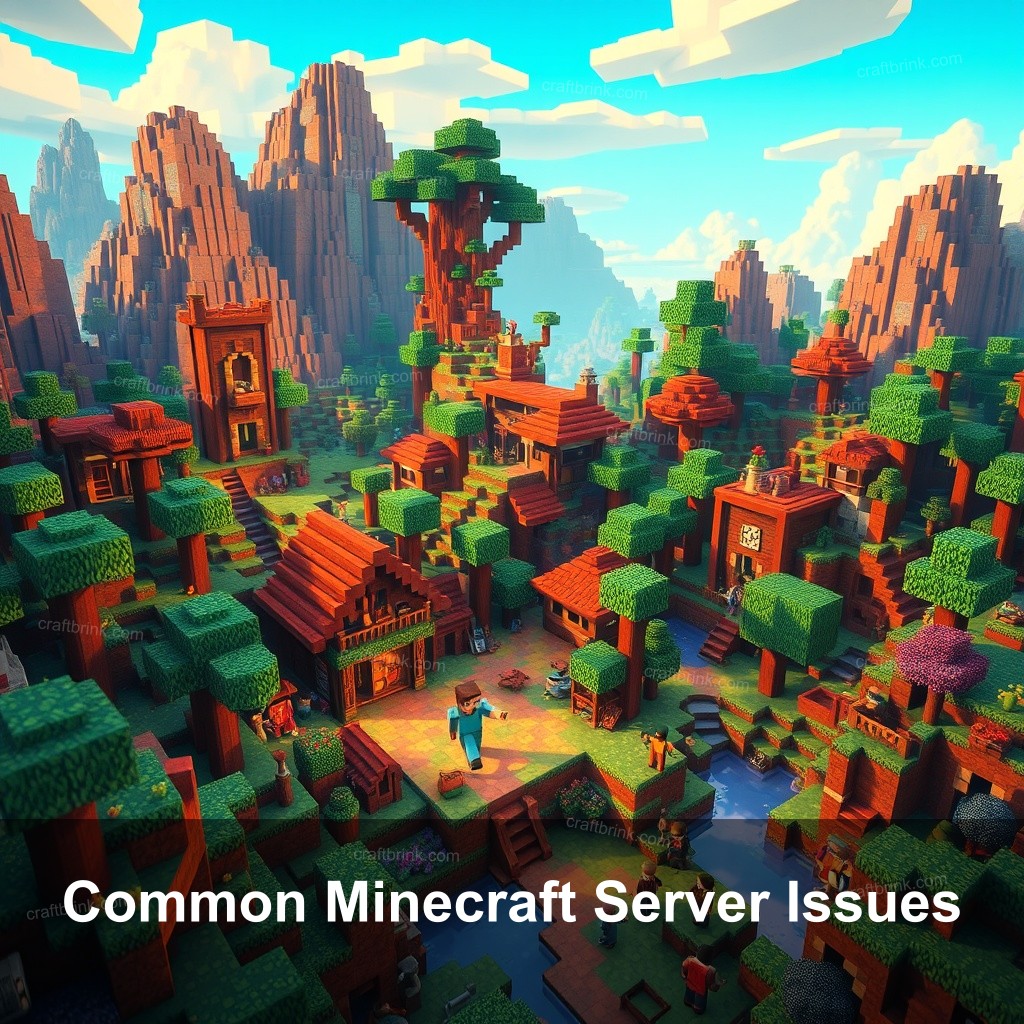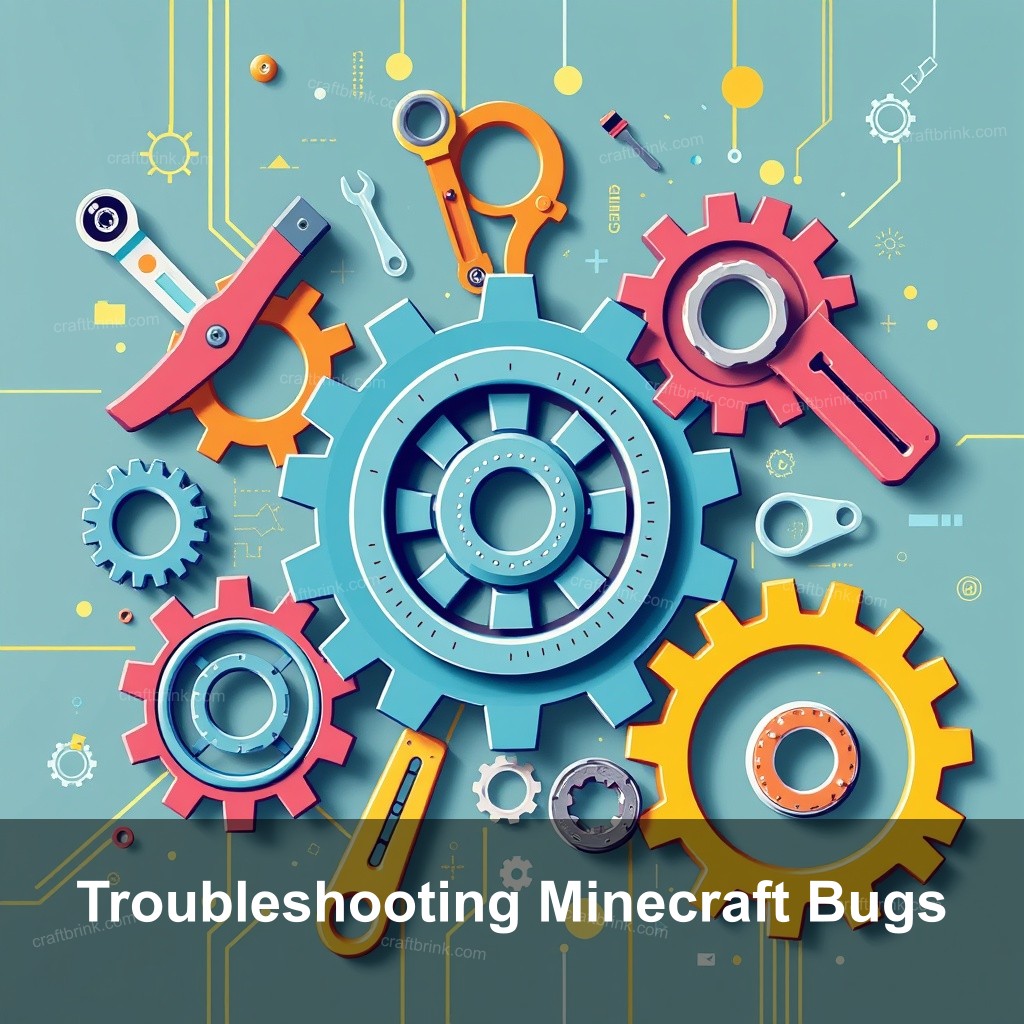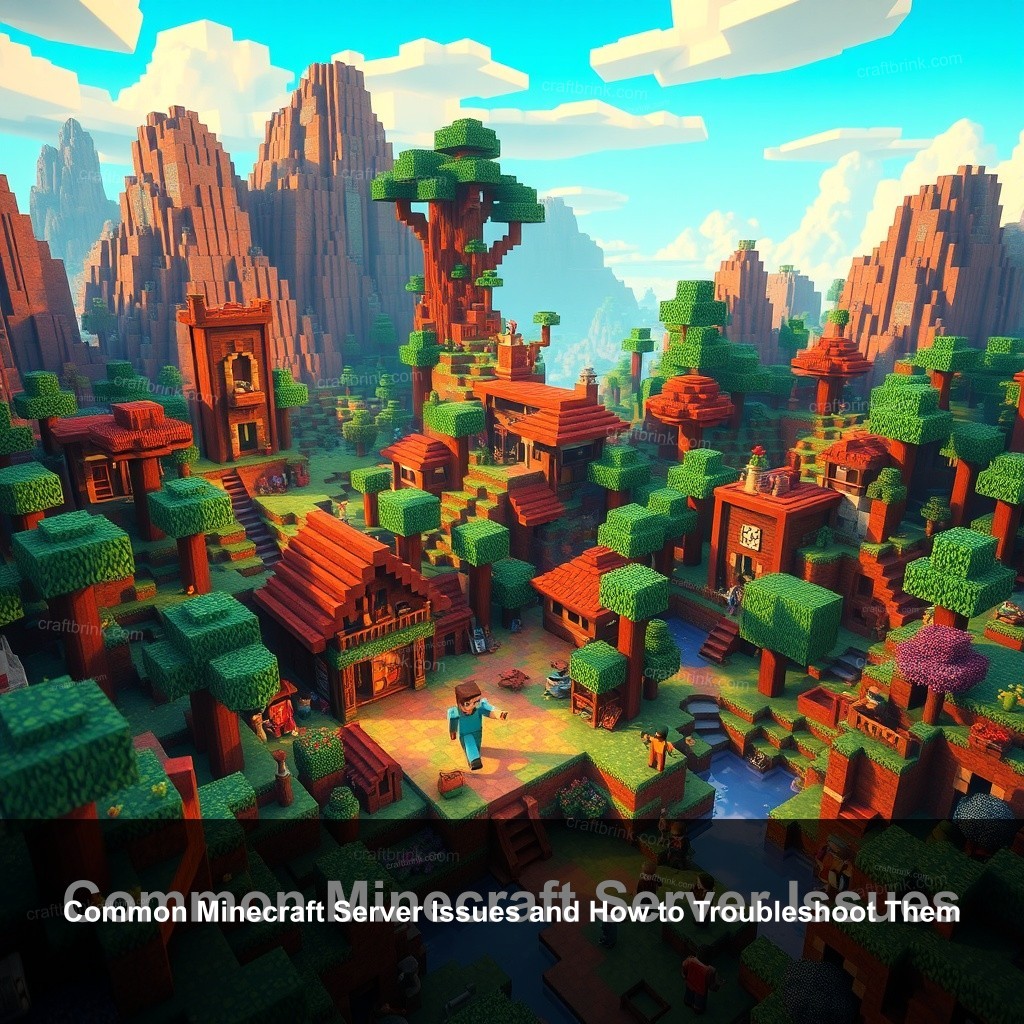Are you frustrated with your Minecraft server acting up? You’re not alone! Many players face challenges like lag, crashes, and other server issues. In this guide, we at CraftBrink will help you identify common Minecraft server issues and provide you with practical troubleshooting strategies. By the end, you’ll be empowered to tackle these challenges and get back to enjoying your blocky adventures!

Common Minecraft Server Issues
When running a Minecraft server, you might encounter various problems that can hinder the gaming experience. From lag spikes to unexpected crashes, these issues can be frustrating. Understanding these challenges is the first step to efficiently resolving them.
| Issue | Description | Possible Causes |
|---|---|---|
| Lag | Delays between player actions and server response. | Insufficient RAM, high player count, or network instability. |
| Crashes | Unexpected shutdown of the server. | Incompatible mods or plugins, lack of resources. |
| Error Messages | Notifications of problems encountered by players. | Configuration errors or server overloads. |
Performance issues are often the most noticeable problems. Players experience lag, which can disrupt gameplay significantly. One major factor contributing to lag is insufficient RAM allocation. If your server cannot handle the number of players or plugins effectively, it will struggle, leading to delays and a poor user experience. For instance, if you’re hosting a server with over 20 players on just 1GB of RAM, expect issues.
Another important aspect to consider is network stability. Connection problems can arise from various sources, such as your internet service provider or network congestion during peak times. It’s crucial to monitor your connection and make sure you have a reliable internet service.
Finally, installing incompatible mods or plugins is one of the various causes of crashes. Should your server crash often, it is advisable to look at the installed components. Look for recent modifications that might have set off instability.
Understanding Performance Issues
Performance issues can significantly affect player experience. To tackle these, consider the following:
- Monitor Resource Usage: Regular checks on CPU and RAM usage can help identify bottlenecks.
- Check Network Stability: A slow or unstable connection can lead to lag. Use tools to monitor your internet speed.
- Update Plugins and Mods: Keeping everything updated can prevent many problems.
By implementing these steps, you can tackle performance issues and improve server responsiveness.
Common Error Messages and Their Solutions
As you run your server, you’ll likely encounter various error messages. Understanding what these errors mean can help you resolve them quickly. One common error is the “Connection Timed Out.” This message typically indicates that players cannot connect due to network issues. To fix this, check your router settings and make sure that your server is online.
Still another often repeated message is the “Internal Server Error.” Usually, configuration issues in the server settings lead to this mistake. Verify that every setting is set exactly. Should you not know where to begin, you can reset your server to default settings and progressively bring back your preferences.
Receiving “Out of Memory” messages indicates that your server is using more RAM than allocated. This situation can happen when too many players are online or when resource-heavy mods are running. You might want to consider increasing your RAM allocation based on your server’s needs.

Troubleshooting Minecraft Bugs
Bugs are an inevitable part of any online game, and Minecraft is no exception. Knowing how to troubleshoot these bugs effectively can save you from prolonged frustration and improve your gameplay experience.
Step-by-Step Troubleshooting Guide
First, always start by checking your server settings. Misconfigurations can lead to various issues, including malfunctioning plugins or mods. Carefully review each setting. For instance, if you’re using a specific plugin for player management, make sure it’s updated and compatible with your server version.
Next, keep your mods updated. Outdated mods can cause compatibility issues, leading to gameplay bugs. Regularly visit the mod developer’s site for updates. If you suspect a mod is causing problems, disable it temporarily to see if performance improves. This method can help identify the culprit.
- Use Diagnostic Tools: These tools can help analyze server performance and detect common issues. Some popular options include Spark and VisualVM, which provide real-time data about server performance and help pinpoint potential problems.
- Engage with the Community: The Minecraft community is vast and supportive. Engaging with online forums can provide insights into bugs others have faced and how they resolved them.
- Consult Official Support: Make sure to utilize official support channels. Mojang provides support for technical issues, and their documentation is a great resource for troubleshooting common problems.
Community Resources for Bug Fixes
The Minecraft community is vast and supportive. Engaging with online forums can provide insights into bugs others have faced and how they resolved them. Popular forums like the Minecraft Forum or Reddit’s r/Minecraft are great places to seek advice.
Another valuable resource is connecting with experienced players. Many veteran players have encountered similar issues and can share their solutions. Don’t hesitate to ask for help. Your server community can be an invaluable resource!
Lastly, make sure to utilize official support channels. Mojang provides support for technical issues, and their documentation is a great resource for troubleshooting common problems. If you’re unable to solve the issue yourself, consider reaching out to their support team.
Fixing Bugs in Minecraft Server
Every Minecraft server owner will encounter bugs at some point. Knowing how to address these issues can keep your server running smoothly and players happy.
Common Bugs and Their Fixes
Gameplay bugs can manifest in various ways. One common issue is problems with block placement. Players may find that blocks aren’t placed correctly, which can be frustrating. This bug often arises from server lag or a disconnect in communication between the client and server. Ensure your server has adequate resources to handle player actions swiftly.
An other common problem is network connectivity flaws. Players can run into failed links or disconnections. Router settings may be the cause of this issue; so, checking your network hardware guarantees that everything is set as it should help to remove these glitches.
- Client-Server Mismatches: These happen when the server version differs from the client version. It’s crucial to maintain consistent versions across your server and all clients to prevent sync issues.
- Regular Backups: They are essential for server health. They ensure that you can recover quickly from crashes or other issues. Set up automatic backups, so you don’t have to remember to do it manually.
- Monitor Server Performance: Using performance monitoring tools allows you to see real-time data about your server’s health. You can catch potential issues before they affect gameplay.
Maintaining Server Health to Prevent Bugs
Regular backups are essential for server health. They ensure that you can recover quickly from crashes or other issues. Set up automatic backups, so you don’t have to remember to do it manually.
Monitoring server performance is also crucial. Using performance monitoring tools allows you to see real-time data about your server’s health. You can catch potential issues before they affect gameplay. For example, if you notice a spike in memory usage, it may be time to investigate what’s causing it.
Automated fixes help to simplify server administration. Think about employing tools or scripts meant to automatically restart the server or solve typical problems. Without continual oversight, automation can help your server run without problems.
Diagnosing Performance Issues in Minecraft
Performance issues can significantly affect player experience. Understanding how to diagnose these problems can help you maintain a high-quality server.
Understanding Server Resource Allocation
Maintaining server performance depends on good distribution of resources. Track routinely the RAM and CPU consumption of your server. Should your server regularly max out its resources, think about changing your hosting arrangement.
Adjusting memory settings can also yield significant improvements. Ensure you allocate enough RAM considering your player count and the number of plugins running. A general rule is to allocate 1GB for every 20 players, but this can vary based on your server’s specific needs.
- Managing Player Load: If you anticipate a surge in players, ensure your server can handle it. Scaling options, such as upgrading your hosting plan or using a dedicated server, can help accommodate more players.
- Using Performance Monitoring Tools: Performance monitoring tools can provide valuable insights into server health. Tools like Minecraft Server Monitor can help you keep track of essential performance metrics.
- Understanding How to Read Performance Metrics: Familiarize yourself with terms like TPS (ticks per second), which indicates how smoothly your server runs. A TPS of 20 means your server is running optimally.
Utilizing Performance Monitoring Tools
Utilizing performance monitoring tools can provide valuable insights into the health of your server. Tools like Minecraft Server Monitor can help you keep track of essential performance metrics, such as player count, RAM usage, and CPU load.
One must be able to read performance measures. Learn words like TPS (ticks per second), which shows the seamless running of your server. With a TPS of 20, your server is running as best it could.
Making data-driven decisions is vital for ongoing server improvement. Use the performance data you gather to inform your choices about resource allocation and plugin management. If certain plugins consistently consume too much RAM, consider alternatives or removing them altogether.
Common Issues and Solutions
Identifying common issues and understanding their solutions can make a significant difference in maintaining a smooth server experience.
Identifying and Solving Specific Issues
When identifying server problems, player comments are a rich source of information. Motivational tools for your athletes to report any issues they come across Get and evaluate this comments often to find trends or repeating problems.
Analyzing server logs can also reveal critical insights. Logs provide detailed information about server activity, including errors and warnings. Familiarize yourself with reading these logs to help pinpoint issues quickly.
- Testing Server Changes: Testing server changes before implementing them live is crucial. Set up a testing environment to ensure that any changes or updates don’t disrupt the gameplay experience. This practice can save you from headaches down the line.
- Establishing Regular Maintenance Routines: Create a schedule for routine checks and updates to keep your server running smoothly. Include tasks such as backing up data, updating plugins, and checking server health.
- Building a Knowledge Base: Creating a knowledge base for common issues can be highly beneficial. Document solutions to problems you’ve encountered, creating a reference for future troubles. A well-organized knowledge base can streamline your troubleshooting process.
Long-Term Solutions to Prevent Recurring Problems
Establishing regular maintenance routines is important. Create a schedule for routine checks and updates to keep your server running smoothly. Include tasks such as backing up data, updating plugins, and checking server health.
One can greatly benefit from building a knowledge foundation for typical problems. Record answers to issues you have come across to serve as a guide for next challenges. A well-ordered knowledge base helps you to troubleshoot more quickly.
Staying updated with Minecraft changes is vital. Regular updates to the game can introduce new features and bug fixes. Keep an eye on patch notes and community discussions to stay informed about what’s happening in the Minecraft world.
FAQ
What are common Minecraft server issues?
Common issues include lag, connection problems, crashes, and error messages. These problems often stem from inadequate resources, network issues, or plugin conflicts.
How can I troubleshoot Minecraft bugs?
Start by checking your server settings and updating any outdated mods. Use diagnostic tools to identify performance issues, and consult community resources for additional support.
What should I do if my server is lagging?
Check your RAM and CPU usage, as insufficient resources often cause lag. Additionally, ensure your internet connection is stable and consider reducing the number of active players or plugins.
How can I fix common error messages?
Identify the specific error message and search for solutions online. Many errors can be resolved by adjusting server settings or ensuring that mods are up-to-date.
Is there a way to prevent server crashes?
indeed! Frequent maintenance—including backups and upgrades—helps avoid crashes. Important also is keeping an eye on server performance and fixing problems as they surface.
Conclusion
In summary, understanding and troubleshooting common Minecraft server issues is important for a smooth gaming experience. By staying informed and proactive, you can improve your server’s performance and keep your players happy. For more tips and insightful content, check out CraftBrink at craftbrink.com.
